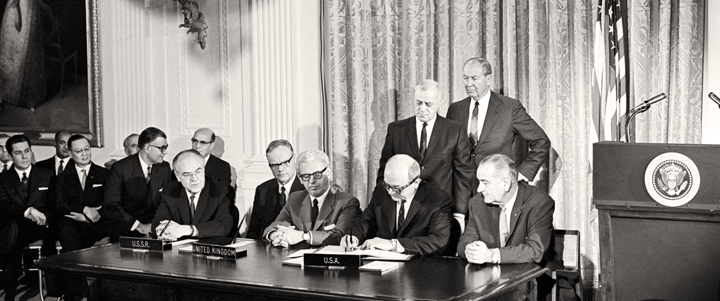The Outer Space Treaty turns 50. Can it survive a new space race?

Photo Illustration by Brenan Sharp
Outer space is nothing like the movies. Contrary to popular imagination, there are no space armadas, Death Stars or laser battles above Earth. Only a handful of humans have ever been to outer space … almost all of them trained astronauts, cosmonauts and scientists.
The reality of space travel is thanks in large part to the Outer Space Treaty, which turns 50 this year. In 1967, a time when only the United States and Soviet Union were even capable of launching vehicles into space, the treaty declared space a demilitarized zone and made the moon and other celestial bodies “the province of all mankind.”
But every so often, something shocking happens that threatens to shatter the soundless peace of outer space. Several years ago, hackers from China cracked into the U.S. weather satellite network and forced a temporary shutdown of the system. More recently, private companies have begun testing commercial rockets designed to take tourists into space—resulting in several explosive failures and one death.
U.S. Rep. Jim Bridenstine, R-Okla., points to these and other incidents as the reasons why comprehensive space law reform is necessary. “Fifty years ago there were two nations in space ... and our main concern was nuclear proliferation,” he says. “Now, almost every nation on Earth has some sort of presence in space, and we have to be concerned with threats like jamming, dazzling [shining disruptive light down from space], spoofing and hacking satellite constellations.”
BILLIONAIRES IN SPACE
The treaty (formally the Treaty on Principles Governing the Activities of States in the Exploration and Use of Outer Space, including the Moon and Other Celestial Bodies; PDF) is a product of the Cold War and primarily addresses concerns of that era, including nuclear war. So for 50 years, the treaty has prevented belligerent nations from putting weapons of mass destruction into space.
But space is becoming big business, and commercial interests are putting new pressures on the law of outer space.
According to The Space Report 2016 (PDF), published by the Space Foundation, a nonprofit advocate for space-related endeavors, at least 19 countries have, are developing or are planning to host spaceports for orbital and suborbital launches. The report counts 86 orbital launches attempted around the world in 2015, and it says “the global space industry grew in 2015,” totaling $323 billion.
This economic activity is still largely driven by national space agencies, but private interests are increasingly reaching for the stars. Nearly 50 years after the U.S. beat the USSR to land the first humans on the moon, a new space race is underway.

Joanne Gabrynowicz. Photo by Gil Ford Photography.
This time, billionaires—including Elon Musk of SpaceX, Jeff Bezos of Blue Origin, Richard Branson of Virgin Galactic and Microsoft co-founder Paul Allen—are racing to launch commercial rockets that could take tourists to space. Last year, Blue Origin’s launch vehicle landed after a suborbital flight and subsequently flew to space and back on two occasions. SpaceX returned the first stage of its Falcon 9 vehicle after an orbital launch. And in January, it resumed launching satellites after a rocket explosion in September.
The financiers and entrepreneurs behind these operations want assurances that regulations are in place that will not stifle the nascent industry. “What the space industry wants is regulatory certainty without regulatory burdens that are going to strangle innovation,” says Bridenstine. “That’s a delicate balancing act.”
As these 21st-century challenges arise, the foundation of space law is still rooted in a series of 20th-century international conventions, beginning with the Outer Space Treaty. (See “Laws in Space.”) The treaty is supplemented by international custom and general principles of law recognized by space-going nations, as well as bilateral agreements among nations. And increasingly, nations are enacting legislation and regulations for commercial space activity.
“Space law is at the jagged edge between legislative and executive power,” says Joanne Gabrynowicz, professor emerita at the University of Mississippi School of Law and editor-in-chief emerita of the Journal of Space Law. “Before the commercialization of space can truly take off, Congress must define the legal framework they will be operating under.”
How big is the gap in the law? In the U.S., there is no federal agency with jurisdiction of on-orbit activity. The Federal Aviation Administration licenses vehicles going up and returning, but no agency actually regulates activity in orbit or on another celestial body. For the most part, Congress had opted to regulate the industry only loosely, granting an extended “learning period” that would allow companies to grow and to practice space travel.
In fact, because man entered outer space before law did, what might have created a military confrontation—spying by satellite—became accepted, if not officially legal. When Sputnik 1 circled the globe on Oct. 4, 1957, the Soviet satellite violated international air law that extends a nation’s sovereignty vertically to the airspace over its territory. But because President Dwight D. Eisenhower knew the U.S. would want to send its own satellites over the Soviet Union, he tacitly accepted its right to operate a satellite in orbit over U.S. territory. Thus, it was established that the rules governing spacecraft would differ from those for aircraft.
But in 2015, the Spurring Private Aerospace Competitiveness and Entrepreneurship Act was passed. The SPACE Act allows companies to mine inorganic resources from space. “Congress wants to allow these interests to go into space and keep the fruits of their labor,” says Michael Dodge, a law professor in the Department of Space Studies at the University of North Dakota. “But property rights in space are a complicated bundle of laws, and they want to promote commercial actions. It’s not clear if it is legal from an international law perspective.”
DOES E.T. SPEAK LEGALESE?
The Outer Space Treaty is not an anomalous or unusual area of law. It is very similar to maritime law, which guarantees peaceful passage through navigable waters by ships of all nations. But in application, the treaty is more similar to the Antarctic Treaty System, a series of international agreements that call for cooperative management of Antarctica as a non-militarized environment, and put off claims of sovereignty for an indefinite period.

The Outer Space Treaty, signed on Jan. 27, 1967, was a product of the Cold War and primarily addresses concerns of that era, including nuclear war. For 50 years, the treaty has prevented belligerent nations from putting weapons of mass destruction into space. Soviet Ambassador Anatoly F. Dobrynin, UK Ambassador Sir Patrick Dean, US Ambassador Arthur J. Goldberg, US Secretary of State Dean Rusk, and US President Lyndon B. Johnson are pictured at its signing on Jan. 27, 1967 in Washington. Photograph courtesy of the United Nations
One of the things that makes space law and the Outer Space Treaty problematic is direct attribution. That is, the treaty makes every nation directly responsible for any activities its citizens engage in above Earth. In particular, Article VI is the foundation on which any laws or regulations regarding commercial space activity are erected. This section makes states responsible for the activities of nongovernmental entities, requiring “authorization and continuing supervision” of space activities by commercial enterprises.
“Direct attribution is a unique feature of space law,” says Chris Johnson, space law adviser for the Secure World Foundation, an organization that promotes “peaceful uses of outer space contributing to global stability and benefits on Earth.” He says that “in other areas of international law, responsibility is more indirect, but in space, citizens are considered to be acting on behalf of their home nation.”
Direct attribution exists because the treaty was very much written to address military, scientific and political questions—not with commercial interests in mind. As a result, there is no framework for regulating or managing commercial actors in space. “The document mentions ‘nongovernmental agencies’ only once,” Gabrynowicz says. “And because of that oversight, there is no U.S. agency with jurisdiction of on-orbit activity. That’s a big gap in the law.”
Another big gap is that there have been virtually no judicial decisions on a question of space law by an international court. Even more problematic, it’s not clear which international court would be called on to settle a dispute in space. In order to fully address these and other concerns, the U.N. would need to amend existing treaties or draft new ones. That would likely be the only way to create binding legal opinions in space law, but in the current political climate, there is little political will or interest in new treaties.
Unfortunately, there are a number of key treaty phrases that remain opaque. For example, Article I says the use of the moon and space resources shall be “the province of all mankind,” while Article V designates astronauts as “envoys of mankind.” Other ill-defined terms at the heart of the treaty include “interests of all other states parties,” “space object,” “harmful interference” and “peaceful purposes.”
“Who exactly is an envoy of mankind? What is the province of mankind?” Johnson asks. “The treaty really doesn’t tell us, and no one has ever had to figure it out.”
These are more than just semantic questions. The vagaries of the treaty and related convention have made it difficult to get more signatories to join the treaty regime. For example, the “Moon Agreement,” the last of the five U.N. treaties relating to space, has been ratified by only 13 nations. Johnson believes this is in large part because commercial interests have been lukewarm to treaty language that reserves lunar resources for “the common interest of all mankind.”
The Outer Space Treaty has faced challenges before. Just over a decade ago, there was an effort to amend or even replace it. At the U.N. Conference on Disarmament in Geneva, bureaucrats considered expanding the categories of prohibited weapons and placing further limits on the military, but the U.S. declined to open new arms control discussions, effectively ending the talks. At the same time, others suggested revisiting the treaty in order to make it conducive to commercial space activities.

Since the recent commercialization of the space race, four billionaires have entered the arena: (clockwise from top) Tesla’s Elon Musk with SpaceX’s Falcon 9, Amazon’s Jeff Bezos with the Blue Origin reusable New Shepard space vehicle, Paul Allen of Microsoft with Vulcan Aerospace’s Stratolaunch Carrier Aircraft with payload rocket and Virgin Group’s Richard Branson with Virgin Galactic’s SpaceShipTwo. Photo Illustration by Brenan Sharp.
“It would be impossible to get a new treaty or amend the existing treaty,” Gabrynowicz says. “It looks like [national] legislation and regulation is the only plausible avenue for modernizing the legal framework in outer space right now. The only question is if Congress can keep up with the space industry.”
THE TREATY WILL ABIDE
Rather than amend the treaty, space-faring nations like the U.S. will likely pass legislation to authorize and supervise space activities. To help shape these efforts, the U.N. released a resolution adopted by the General Assembly in 2013 outlining how national legislation can comport with the treaty. The document (PDF) contains a set of recommendations on national legislation relevant to the peaceful exploration and use of outer space, emphasizing “sustainable use” of outer space resources and reminding states of their responsibility for supervising space activity originating from their territories.
Bridenstine has proposed the American Space Renaissance Act (PDF), which would bring about significant changes in the nation’s commercial space policy, starting with a much larger role for the Department of Transportation and the Commerce Department. These agencies’ budgets would be increased significantly to keep up with growth in the commercial space industry. New initiatives include a loan guarantee program, tax credits for the domestic launch industry and funding for a variety of prizes.
Bridenstine does not expect ASRA to pass as a whole. Instead, provisions would be incorporated into other legislative measures as events warrant. Among his concerns is that existing treaty language would allow foreign powers to interfere with or thwart economic activity unless U.S. law is amended to give legal protections to space activity.
“Imagine a new company is about to attempt a rendezvous and proximity maneuver, like refueling a satellite,” he says. “There is a real concern another nation could declare this was a provocative act and all of a sudden a multimillion-dollar project is stopped. Companies need confidence and regulatory certainty that they can proceed with new ventures.”
The SPACE Act was the first major update to U.S. space law explicitly allowing “U.S. citizens to engage in commercial exploration for and commercial recovery of space resources free from harmful interference.” Because the Outer Space Treaty has no clear prohibition against the taking of resources, the law assumes that the use of space resources is permitted.
The primary motivation behind the U.S. law was to help private interests begin the exploitation of space resources. In 2016, the FAA announced that it had cleared a company called Moon Express to launch an unmanned mission as early as this year—the first private moon landing. While the Outer Space Treaty clearly bars countries from making a territorial claim, SPACE assumes that broad commercial exploration and use of celestial objects such as asteroids or the moon is legal, something that is not a universal view.
In fact, SPACE is just one possible interpretation of the treaty; whether and to what extent this interpretation is shared by other nations remains to be seen. For now, the law regulates a hypothetical practice until commercial projects, space tourism and mining operations begin. “The fact is that the treaty considers celestial bodies ‘common heritage,’ and no nation has the right to unilaterally declare these resources private property,” says Timothy G. Nelson, a Skadden Arps Slate Meagher & Flom partner in New York City who specializes in international law.

Chris Johnson.
Meanwhile, Spaceport America in the New Mexico desert is the first commercial spaceport in America, giving Virgin Galactic and others a launching pad for putting tourists into space. And Deep Space Industries plans to begin mining resources from asteroids within three years. Congress will have to act to prevent the regulatory regime from becoming a serious impediment.
“In my experience, motivated offices will find a way to make something happen or to find an excuse why they cannot allow something in space. It all depends on political will,” says Ann Liebschutz, executive director of the United States Israel Science & Technology Foundation. “If the commercial interests can motivate the government to act, the space race can continue.”
But in addition to nascent commercial concerns, fear is a powerful motivating force behind proposed new legislation. New threats to existing space assets have emerged that are not addressed by the treaty. One example: Nuclear weapons are not allowed in space, but hacking is a provocative act—and potentially a cause for war. The treaty was conceived before these threats existed, and holding parties accountable for interference in space activities is difficult.
“We need to make our space-based assets more resilient,” says Bridenstine. “If someone attacks us in space, we reserve the right to respond terrestrially.”
But even if American legislators want to create penalties or sanctions for space-based treachery, holding nations responsible for activities in space has been an impossible task. In January 2007, the Chinese used a projectile from a ballistic missile to destroy one of their own aging weather satellites. The blast left a trail of space flotsam that, according to NASA, now accounts for 42 percent of all satellite breakup debris, a large component of the orbiting man-made detritus known as space junk. This provocative act was widely condemned, but no legal action was pursued.

Rep. Jim Bridenstine. Photograph Courtesy of the Office of U.S. Representative Jim Bridenstine.
BE A SPACE LAWYER
Space law is an obscure but important field. Its complex mixture of international and domestic laws includes administrative, intellectual property, arms control, insurance, environmental, criminal and commercial law, as well as international treaties and domestic legislation written specifically for space.
But as the prospects for commercial ventures in space increase, it will be necessary to address the issue of who will be allowed to profit from the fruits of those ventures. This will demand lawyers with a rare blend of talents.
The profile of a space lawyer is changing. In the past, space law was the domain of aerospace and defense industry attorneys. Now a company or organization may need lawyers to help get a new service into the air. The challenge will be to reconcile the last-century treaty with this-century challenges. “The thing we academics have to explain is the Cold War thinking that influenced the treaty,” says Dodge from the University of North Dakota. “We live in a very different time, but the treaty language has to apply to today’s realities.”
Still, despite its shortcomings, the Outer Space Treaty has endured for 50 years. Supporters say that, just like the U.S. Constitution, the treaty’s basic values are fundamental and applicable in any age.
“When the framers of the Constitution wrote the Fourth Amendment, they knew that the government could not be allowed to conduct unreasonable search of a person,” Gabrynowicz says. “Fast-forward 225 years, when GPS satellites in space are used to track persons, but the Fourth Amendment still applies.
“The Outer Space Treaty proposed that space should only be used for peaceful purposes,” she says. “That’s the principle. It’s no less ambiguous than due process or other fundamental principles.”
Sidebar: 5 United Nations treaties in space
Jason Krause is a freelance writer based in Madison, Wisconsin. This article originally appeared in the April 2017 issue of the ABA Journal with this headline: "Rocket Law."



